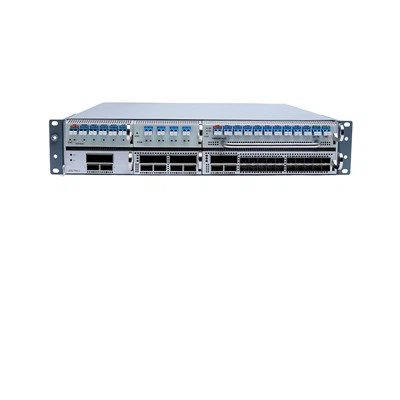Optical fiber is a thin, soft, solid glass material. It consists of a core, a cladding, and a coating. It can be used as a light transmission tool.

ITU-T recommended classification: G.651, G.652, G.653, G.654, G.655, G.656, G.657
SMF (Single Mode Fiber) single-mode fiber types are as follows:
-G.652 (dispersion non-shifting single-mode fiber)
-G.653 (dispersion-shifted fiber)
-G.654 (cut-off wavelength-shifted fiber)
-G.655 (non-zero dispersion-shifted fiber)
-G.656 (low-slope non-zero dispersion-shifted fiber)
-G.657 (bend-resistant fiber)
G.652 dispersion non-shifting single-mode fiber
G.652 fiber is a conventional single-mode fiber with the shortest cut-off wavelength, which can be used for both 1550nm and 1310nm.
When the working wavelength is 1310 nm, the fiber dispersion is very small, and the dispersion coefficient D is 0 ~ 3.5 ps / nm · km. The transmission distance of the system is limited only by the fiber attenuation. However, the loss is large, about 0.3 to 0.4 dB / km.
The loss at the working wavelength of 1550 nm is small, about 0.19 to 0.25 dB / km, but the dispersion is large, about 20 ps / nm · km.
This fiber can be used in 2.5Gbps systems in the 1550nm band, but because of the large dispersion in this band, if a 10Gbps signal is transmitted and the transmission distance exceeds 50 kilometers, a dispersion compensation module must be used.
.G.652 optical fiber is a kind of optical fiber with many applications. ITU-T divides G.652 into 4 types of optical fibers: G.652.A, B, C, and D.
G.652.A fiber
The highest transmission rate is 2.5Gbps
G.652.B fiber
The highest rate is 10Gbps. Dispersion compensation is required for the highest rate transmission. It is suitable for applications with wavelengths of 1310nm / 1550nm / 1625nm. Such fibers have small bending loss and small transmission loss.
G.652.C fiber
The chirp property is basically the same as G.652A, but the attenuation coefficient is lower at 1550nm, and the water absorption peak near 1380nm is eliminated. Can work in the 1360nm ~ 1530nm band.
G.652.D fiber
Properties are basically the same as G.652B fiber, and the attenuation coefficient is the same as G.652C fiber, that is, it can work in the 1360nm ~ 1530nm band. It is the most stringent of all G.652 levels and is fully backward compatible.
G.653 dispersion-shifted fiber
G.653 Dispersion Shifted Fiber (DSF, Dispersion Shifted Fiber), based on G.652 fiber, moves the zero dispersion point from 1 310 nm to 1 550 nm. Limitations of the system.
This fiber is very suitable for long-distance, single-channel, high-speed optical fiber communication systems. For example, a 20G b / s system can be directly opened on this fiber without the need for any dispersion compensation measures. However, due to the use of EDFA in DWDM, the optical power entering the fiber has been greatly improved. The four-wave mixing caused by the nonlinear effect of the fiber has a serious impact on the DWDM system on the G.653 fiber. G.653 has not been widely used. Promotion. The main reason is that in the 1 550 nm window, the dispersion of G.653 is very small, and it is relatively easy to produce various optical nonlinear effect networks.
G.654 cut-off wavelength-shifted fiber
G.654 fiber is the fiber with the smallest loss at 1550nm wavelength. It is mainly used for submarine fiber communication that requires a long regeneration distance. Submarine optical fiber communication system.
G.655 non-zero dispersion shifted fiber
G.655 Non-Zero Dispersion Shifted Fiber (NZDSF, NonZero Dispersion Shifted Fiber) has reasonable and low dispersion in the 1 550 nm window, can reduce non-linear effects such as four-wave mixing and cross-phase modulation, and can support long distances Transmission while minimizing dispersion compensation networks.
The low dispersion slope G.655 fiber has a dispersion value of less than 0.05 ps / nm · km, a dispersion value of 2.6 to 6.0 ps / nm · km in the wavelength range of 1 530 to 1 565 nm, and a wavelength range of 1 565 to 1 625 nm. The dispersion value is 4.0 to 8.6 ps / nm · km.
G.656 low-slope non-zero dispersion-shifted fiber
G.656 fiber is designed to further expand the usable wavelength range of DWDM systems, A new type of fiber, which maintaining non-zero dispersion in the S (1460 ~ 1530 nm), C (1 530 ~ 1 565 nm) and L (1 565 ~ 1 625 nm) waveband.
G.657 bend resistant fiber
G.657 fiber Compared with other single-mode fibers, the most significant feature of G.657 fiber is that it is less sensitive to bending and has less bending loss.
According to the principle of compatibility with G.652 optical fiber, G.657 is classified into A and B optical fibers, and the bending level is divided into three levels of 1, 2, and 3 according to the principle of minimum bendable radius.





















